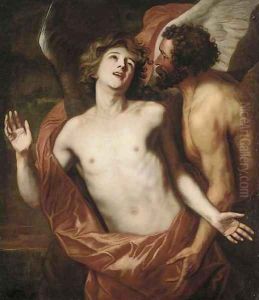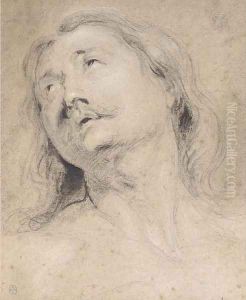Thomas Willeboirts, Called Bosschaert Paintings
Thomas Willeboirts Bosschaert was a distinguished Flemish Baroque painter born in Bergen op Zoom in 1613. Despite being born in the Dutch Republic, his career flourished in the Southern Netherlands, primarily in Antwerp, where he moved with his family during his early childhood. This relocation was pivotal for his artistic development, immersing him in the rich cultural and artistic environment that characterized the Flemish region during the 17th century. Willeboirts Bosschaert is often associated with the second generation of Flemish Baroque painters, succeeding the pioneering works of Peter Paul Rubens and contemporaneous with artists such as Jacob Jordaens and Anthony van Dyck. His works are known for their meticulous attention to detail, vibrant colors, and dynamic compositions, embodying the Baroque spirit of drama, emotion, and movement.
Willeboirts Bosschaert's training began under the tutelage of Gerard Seghers, a prominent figure in the Antwerp art scene, known for his Caravaggist style. This apprenticeship was crucial in shaping Bosschaert’s early style, incorporating the chiaroscuro and dramatic intensity typical of Caravaggio’s influence. In 1637, he became a master in the Antwerp Guild of Saint Luke, marking the beginning of his professional career. He quickly established himself as a versatile artist, adept in creating history paintings, portraits, and mythological scenes. His ability to blend the theatricality of the Baroque with a nuanced understanding of human emotion garnered him significant attention and patronage, including commissions from the Spanish Habsburg rulers who governed the Southern Netherlands at the time.
During his career, Willeboirts Bosschaert also collaborated with other artists, contributing figures to landscapes and still lifes. His work is characterized by a refined elegance and a keen observation of detail, qualities that made him a favorite among the nobility and religious institutions. Despite the success and recognition he enjoyed during his lifetime, Willeboirts Bosschaert's legacy was somewhat overshadowed by his contemporaries in the centuries that followed, leading to a period of obscurity.
However, recent scholarship has begun to reassess his contribution to the Flemish Baroque, highlighting his role in the transition between the high Baroque style of Rubens and the more classical approach that would dominate the latter part of the 17th century. Thomas Willeboirts Bosschaert died in Antwerp in 1654, leaving behind a body of work that continues to be studied and appreciated for its artistic merit and historical significance.

